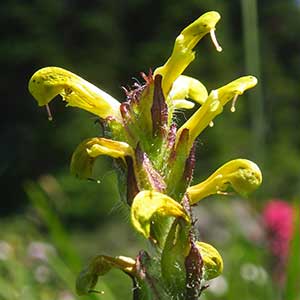Pedicularis rainierensis
Pedicularis pulchella
Mt. Rainier lousewort
mountain lousewort, pretty dwarf lousewort
basal 2–5, blade lanceolate, 40–80 x 3–20 mm, 2-pinnatifid, margins of adjacent lobes nonoverlapping or slightly overlapping distally, serrate to 2-serrate, surfaces glabrous;
cauline 2–6, blade lanceolate, 15–70 x 5–20 mm, 1- or 2-pinnatifid, margins of adjacent lobes nonoverlapping or slightly overlapping distally, serrate, surfaces glabrous.
basal 15–20, blade lanceolate to elliptic, 10–20 x 5–10 mm, 2- or 3-pinnatifid, margins of adjacent lobes extensively overlapping, serrate, surfaces glabrous;
cauline 4–10, blade elliptic, 10–25 x 3–7 mm, 2- or 3-pinnatifid, margins of adjacent lobes extensively overlapping throughout, serrate, apex cuspidate, surfaces glabrous or tomentose.
simple, 1–4, exceeding basal leaves, each 10–50-flowered;
bracts lanceolate or subulate to trullate, 10–15 x 1–2 mm, undivided or pinnatifid, proximal margins entire, distal serrate, surfaces glabrous or tomentose.
simple, 1–4, exceeding basal leaves, each 8–50-flowered;
bracts lanceolate or elliptic to trullate, 4–25 x 3–6 mm, 2-pinnatifid, adjacent margins extensively overlapping, proximal margins entire, distal cuspidate, surfaces glabrous or tomentose.
1–3.5 mm.
4–10 mm.
calyx 7.5–11 mm, hispid to tomentose, lobes 5, linear to narrowly triangular, 4–5 mm, apex entire, glabrous or ciliate;
corolla 16–19 mm, tube light or dark yellow, 8–10 mm;
galea light or dark yellow, 8–9 mm, beakless, margins entire medially and distally, apex arching beyond abaxial lip;
abaxial lip light or dark yellow, 4–5 mm.
calyx 8–12 mm, tomentose, lobes 5, triangular, 1.5–3 mm, apex entire or pinnatifid to serrate, glabrous;
corolla 17–27 mm, tube violet-red, 9–10 mm;
galea violet-red, 7–15 mm, beakless, margins entire medially, 1-toothed distally, apex arching over abaxial lip;
abaxial lip violet-red, 6–9 mm.
Pedicularis rainierensis
Pedicularis pulchella
Pedicularis rainierensis is known from Mt. Rainier and the Crystal Mountain area. The species is easily confused with P. bracteosa var. latifolia, which often occurs in the same meadows. While the sizes and shapes of their flowers are nearly indistinguishable, P. rainierensis is a much smaller plant with leaves only about three fourths the size, proximal leaf lobes less than one fifth the size, inflorescences about one half the length, and the number of flowers greatly reduced in comparison to those of P. bracteosa var. latifolia.
(Discussion copyrighted by Flora of North America; reprinted with permission.)
Pedicularis pulchella occurs in the Absaroka and Beartooth ranges of southwestern Montana and northwestern Wyoming, the Anaconda and Madison ranges of Montana, and one site in the Cascade Range of Washington. The overlapping adjacent lobes of its two-, or sometimes three-, pinnatifid leaves are a characteristic feature of P. pulchella.
(Discussion copyrighted by Flora of North America; reprinted with permission.)


